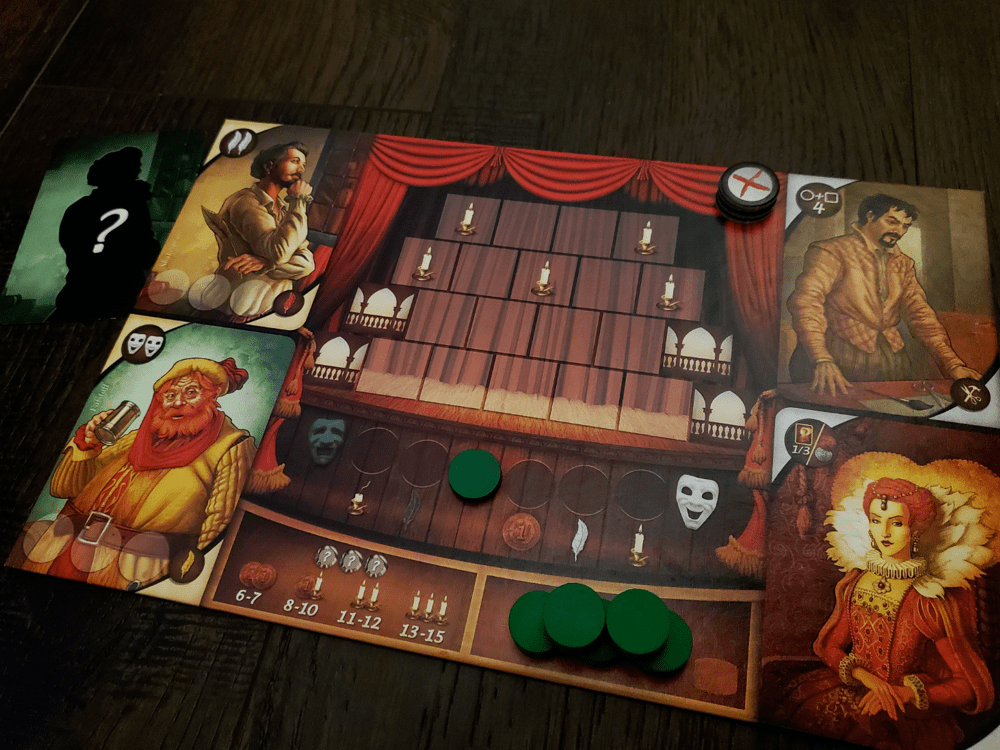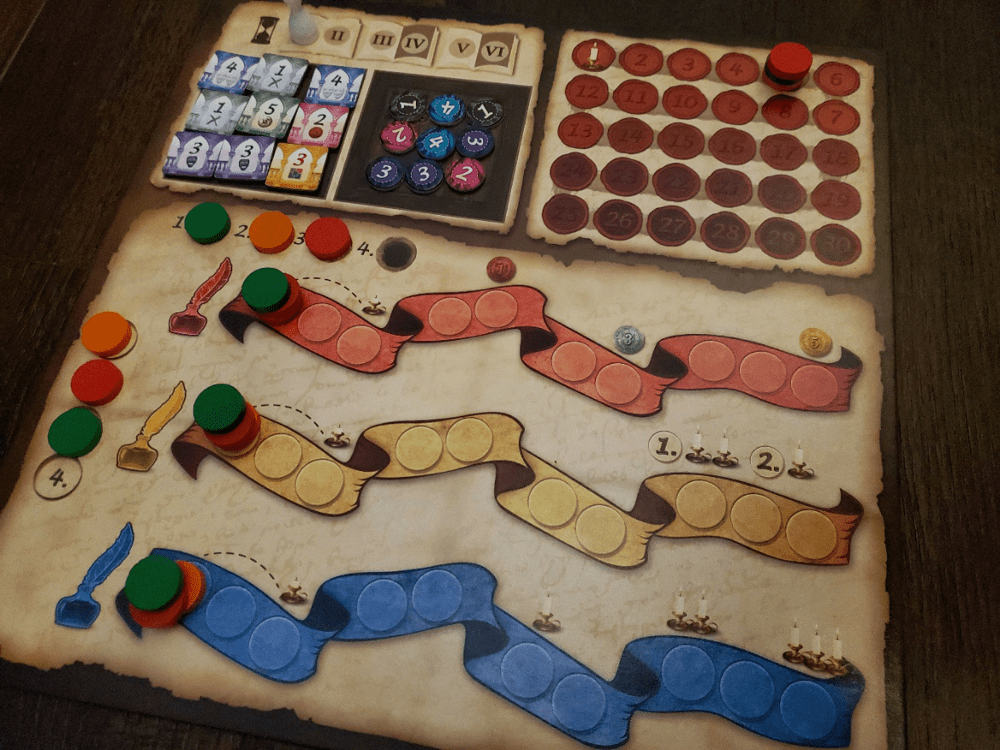That was laid on with a trowel
It was a fleeting moment, little more, in which I contemplated setting out to write a fair review with poetry. But when I realized that I lacked the skill and patience needed, I forsook the whole endeavor in the middle of a line. Who writes in iambs and pentameter today? In rhyme or blank, the business is but lost, forever damned to high school English class.
But man, that Shakespeare fellow had a gift. I guess you don’t receive a nickname like the Bard without a talent worth the moniker. And while our time is better spent before the poetry and plays that brought him fame, a goodly set of games exist that try to aptly celebrate his name and work.
The board game trade that opened up the gates and set me on a path where I would learn to curate my collection introduced Hervé Rigal’s Shakespeare into my life. Ystari Games in 2015 gave the world a taste of theater and bent the Globe’s unrivaled playwright so to match Elizabethan times with modern ways.
And thus an invitation I extend that you might better know a favorite game.
Be not afraid of greatness
Shakespeare invites players to spend six days putting together a production worthy of the Queen by recruiting actors and hiring men and women to design costumes and build a set. Two pending dress rehearsals provide the pressure—that and a load of hired help that wants to be paid by opening night.
Each player’s board is a bare stage with a track measuring ambiance. To the left, actors will join the company via cards, with Shakespeare and Falstaff as starters. To the right, cards representing the craftsmen and women will join the crew. A single space for appealing to the Queen is also among the starting options.

Each day begins with an auction in which players bid the number of turns they intend to take. The player who bids the least becomes the first player and receives a bonus point on the Prestige track. The track only measures 30 points, and games rarely reach beyond 25, so every point matters.
Players then use markers to call upon actors and crafters to provide their services. Based on the value of each crafter, they can claim either set tiles or costume tokens. The set tiles are deployed on player stages, but must be arranged symmetrically and built like bricks from bottom to top. Most tiles provide a bonus: coins, ambiance, crafter boosts, etc. and those near the top also grant Prestige points. Each actor has room for three costume tokens. Once fully dressed, these costumes award bonuses based on their total value. Fully dressed actors also provide bonuses during the dress rehearsal. If ever a player uses the special goldsmith to craft a golden element, they come with an endgame reward.
Actors are a bit of a mixed bag and serve each of the play’s three acts. There are three tracks on the central board representing acts of a play and marked by a colored quill. The red track provides money. The yellow track is a race to the end with first and second place receiving Prestige. The blue track grants Prestige equally to all who reach the milestones. When activated, each of the actors grant advancement along one or more tracks. The more lucrative troupers also provide minimal costume and set bonuses or movement on the ambiance track.

One side action that is almost always forgotten in the game (I nearly forgot to write about it here) is an initiative track. When players activate their first actor on a given day, they place a marker on the initiative track, which is used to break ties at various points. Because the crafters are typically more contentious early in the round, an early visit to the actors is perhaps worth rewarding.
The only action that doesn’t require a marker is recruiting. Each day players must recruit one more human into their company from a market of cards as one of their turns. There is no upfront cost, but each card shows the required payment at the game’s end. Failure to pay brings a penalty.
Should a player visit the Queen, they either walk away with coins or endgame objective cards that score either one or two Prestige. These cards are useful, but it’s hard to see their value in the game because they seem to be worth so little.
Once all the turns are complete, players evaluate the ambiance of their theater. Various tiles and cards will drive this track up and down throughout the round, issuing either a penalty or a reward of coins, quill tracks, or Prestige points. The marker is then reset for the next day and players assign rest tokens to all but one of their used characters, making them unavailable for the next day.

Days four and six end with a dress rehearsal. Each player, in order of the initiative track, gathers bonuses from each actor who is fully dressed. Most of these bonuses are colored quills. Then each quill track is scored for coins or Prestige.
After day six it’s time to take to the stage for the adoring public, so the game ends. Objective cards are scored, actors and crafters are paid (or else), and any gold elements crafted in the game receive a bonus point on the way to a final score.
Love sought is good, but given unsought is better
I acquired Shakespeare with the highest of expectations. I had been waiting and watching for some time. Due to the average cost on the used market, I was afraid I’d never have a copy of my own. It’s rare that a game so fully rises to its occasion. I adore this one, and I’m so glad the trade came my way. I only wish the Backstage expansion wasn’t in many cases more expensive than the base. But lightning struck once, so I suppose I can hold out hope awhile longer.
The backside of Shakespeare’s rulebook contains a section on Theme that explains several of the game’s historical anachronisms. The decision to include females among the actors, to earn money before the first official show, to impose value on costumes, and to include dress rehearsals as such are all laid out with clarity for the thematic naysayers. Personally, I’m at peace with the anachronisms. As much as I would have loved a Richard Burbage card and a thrust stage, I really can’t complain about the quirks. I wouldn’t change the Lady Macbeth, Beatrice, or Titania in this box for anything.

On the character front, there are subtleties alive in the cards that are enjoyable. Lady Macbeth is a boon to all three acts if you can get her costumed by dress rehearsal. Lear boosts the ambiance in the room every time you visit him. Iago drives the first two act tracks, and if you get him dressed he’ll contribute to the third. Juliet is a costume boost and especially helpful to the first act. Puck is all about the third act and raises the ambiance overall. It’s fun to think about how much this matters, or whether it matters at all.
The interaction of the opening bid and the rest tokens is spectacular. To start the game, each player has five available actions and five turn markers. Taking every action is appealing, but will cripple the following round when four characters are forced to rest. The interesting dynamic is timing the willful self-sacrifice of turns for a potential bonus point in exchange for a more active tomorrow. By the game’s end, with ten and eleven characters in play, the struggle is no less stressful, it just includes more markers. I love this decision space.
Starting the game with no money is unusual and unusually wonderful. Every crafter and actor costs one, three, or five coins, and the economy is just tight enough to present rich choices. Watching an opponent use their crafter’s value of eight to snag four of the set tiles that grant coins can be painful when you’ve recruited Hamlet and Lear with their high price tags. The temptation is real to craft slightly less gaudy costumes in order to secure the coin bonus rather than the Prestige that comes with more flashy attire. The ambiance track also exerts itself on your emotions as you tenuously hold the position that will grant a coin.

While we’re on that subject, the ambiance track is a world all its own. Purple set pieces marked with a three, when purchased, force everyone else to drop by one on the ambiance track. If players choose to play nice and leave those pieces behind, everyone is penalized. What a wicked world! But it keeps you on your toes trying to avoid penalties and gain the needed rewards.
The Queen’s objectives are bland and questionably useful. Most often they find their greatest draw during the final day when folks are all about using five turn markers. At that point, it feels a little like a dumpster dive that can swing the game, which is unfortunate. Most often, the one or two points could just as easily be obtained elsewhere, though, so I can’t complain all that much. They don’t lend themselves to any sort of strategy, but they are there. These cards might be the most lukewarm aspect of the game.
O flatter me; for love delights in praises
Overall, I celebrate a game that always plays out as a fairly casual tooth-and-nail battle for less than thirty points; one that invites self-sacrifice for specific gain and a long-term edge. I love the subject matter and I’m thrilled that the gameplay fits so beautifully. Did it have to be Shakespeare? No. As a theater game, it could just as easily have been Hamilton given their shared 2015 release. But I wouldn’t have this game any other way. I’m glad there are deeper materials out there in my future. I would gladly welcome more. I hope it earns a tricked-out reprint some day.
As time continues on, however, I must toast our Shakespeare, our beloved Bard.
(Nearly) one year later
Every time I play Shakespeare, it grows more estimable in my sight. At the time this review originally published, I only had three perfect 10’s in my collection. I am ready to say with confidence that Shakespeare is the fourth. Bidding with your turns is a brilliant mechanism that is in constant conversation with the knowledge that the majority of those active cards will be granted rest in the following round. The timed release of costume pieces and stage rewards draws attention in every round. I’m increasingly enamored with the occasional nudge from the Queen to pursue a course of action that is only marginally rewarding. And as I read and re-read plays, view and re-view productions and adaptations, plow through episodes of Upstart Crow, and occasionally work through a play with my students, I love the cards all the more. In short, the aspects of this game that are enjoyable become more so every time I open the box. With reverent agony, I am considering cutting the box down in height in the name of shelf space and efficiency; but I do so only because I cannot fathom a circumstance in which I would ever allow this one to slip away.
I looked again this morning for a reasonable trade for Backstage or the Prospero promo. No luck.











Add Comment